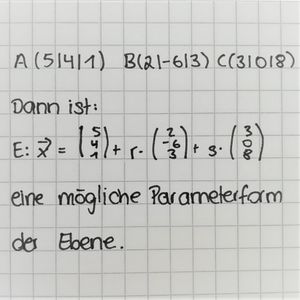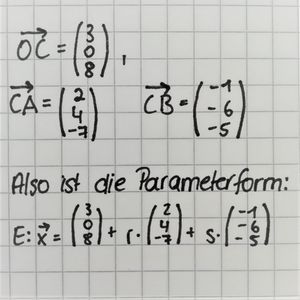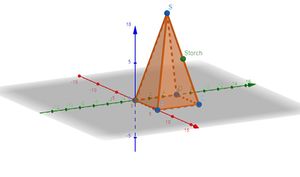Digitale Werkzeuge in der Schule/Unterwegs in 3-D – Punkte, Vektoren, Geraden und Ebenen im Raum/Ebenen im Raum: Unterschied zwischen den Versionen
Aus ZUM Projektwiki
< Digitale Werkzeuge in der Schule | Unterwegs in 3-D – Punkte, Vektoren, Geraden und Ebenen im Raum
Markierung: Quelltext-Bearbeitung 2017 |
Markierung: Quelltext-Bearbeitung 2017 |
||
| Zeile 400: | Zeile 400: | ||
Ein Normalenvektor <math>\vec{n}=\begin{pmatrix} 2 \\ -1 \\ 5 \end{pmatrix}</math> muss zu den Spannvektoren <math>\begin{pmatrix} 1 \\ -1 \\ 0 \end{pmatrix}</math> und <math>\begin{pmatrix} 1 \\ -3 \\ 4 \end{pmatrix}</math> orthogonal (senkrecht) sein, also ist <math>\begin{pmatrix} n_1 \\ n_2 \\ n_3 \end{pmatrix} \cdot \begin{pmatrix} 1 \\ -1 \\ 0 \end{pmatrix}=0</math> und <math>\begin{pmatrix} n_1 \\ n_2 \\ n_3 \end{pmatrix} \cdot \begin{pmatrix} 1 \\ -3 \\ 4 \end{pmatrix}=0</math>. | Ein Normalenvektor <math>\vec{n}=\begin{pmatrix} 2 \\ -1 \\ 5 \end{pmatrix}</math> muss zu den Spannvektoren <math>\begin{pmatrix} 1 \\ -1 \\ 0 \end{pmatrix}</math> und <math>\begin{pmatrix} 1 \\ -3 \\ 4 \end{pmatrix}</math> orthogonal (senkrecht) sein, also ist <math>\begin{pmatrix} n_1 \\ n_2 \\ n_3 \end{pmatrix} \cdot \begin{pmatrix} 1 \\ -1 \\ 0 \end{pmatrix}=0</math> und <math>\begin{pmatrix} n_1 \\ n_2 \\ n_3 \end{pmatrix} \cdot \begin{pmatrix} 1 \\ -3 \\ 4 \end{pmatrix}=0</math>. | ||
Hieraus folgt <math>n_1-n_2=0</math> <math>n_1-3n_2+4n_3 =0</math>. Wählt man z.B. <math>n_2=2</math>, so erhält man durch Einsetzen in die Gleichungen des Gleichungssystems und Umformen <math>n_1=2</math> und <math>n_3=1</math> und damit <math>\vec{n}=\begin{pmatrix} 2 \\ 2 \\ 1 \end{pmatrix}</math>. | Hieraus folgt | ||
<math>n_1-n_2=0</math> | |||
<math>n_1-3n_2+4n_3 =0</math>. | |||
Wählt man z.B. <math>n_2=2</math>, so erhält man durch Einsetzen in die Gleichungen des Gleichungssystems und Umformen <math>n_1=2</math> und <math>n_3=1</math> und damit <math>\vec{n}=\begin{pmatrix} 2 \\ 2 \\ 1 \end{pmatrix}</math>. | |||
Ansatz für die Koordinatengleichung: <math>E\colon 2x_1+2x_2+x_3=d</math>. | Ansatz für die Koordinatengleichung: <math>E\colon 2x_1+2x_2+x_3=d</math>. | ||
Version vom 9. Mai 2021, 21:23 Uhr
Die Parameterform und die Punktprobe
Die Punktprobe
Spurpunkte
⭐ Normalenvektor
⭐ Normalenform und Koordinatenform von Ebenengleichungen
⭐Überführung der Parameterform in die Koordinatenform






